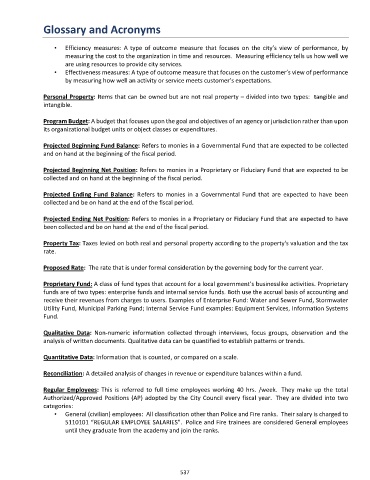Page 576 - Fort Worth City Budget 2019
P. 576
Glossary and Acronyms
• Efficiency measures: A type of outcome measure that focuses on the city’s view of performance, by
measuring the cost to the organization in time and resources. Measuring efficiency tells us how well we
are using resources to provide city services.
• Effectiveness measures: A type of outcome measure that focuses on the customer’s view of performance
by measuring how well an activity or service meets customer’s expectations.
Personal Property: Items that can be owned but are not real property – divided into two types: tangible and
intangible.
Program Budget: A budget that focuses upon the goal and objectives of an agency or jurisdiction rather than upon
its organizational budget units or object classes or expenditures.
Projected Beginning Fund Balance: Refers to monies in a Governmental Fund that are expected to be collected
and on hand at the beginning of the fiscal period.
Projected Beginning Net Position: Refers to monies in a Proprietary or Fiduciary Fund that are expected to be
collected and on hand at the beginning of the fiscal period.
Projected Ending Fund Balance: Refers to monies in a Governmental Fund that are expected to have been
collected and be on hand at the end of the fiscal period.
Projected Ending Net Position: Refers to monies in a Proprietary or Fiduciary Fund that are expected to have
been collected and be on hand at the end of the fiscal period.
Property Tax: Taxes levied on both real and personal property according to the property's valuation and the tax
rate.
Proposed Rate: The rate that is under formal consideration by the governing body for the current year.
Proprietary Fund: A class of fund types that account for a local government’s businesslike activities. Proprietary
funds are of two types: enterprise funds and internal service funds. Both use the accrual basis of accounting and
receive their revenues from charges to users. Examples of Enterprise Fund: Water and Sewer Fund, Stormwater
Utility Fund, Municipal Parking Fund; Internal Service Fund examples: Equipment Services, Information Systems
Fund.
Qualitative Data: Non-numeric information collected through interviews, focus groups, observation and the
analysis of written documents. Qualitative data can be quantified to establish patterns or trends.
Quantitative Data: Information that is counted, or compared on a scale.
Reconciliation: A detailed analysis of changes in revenue or expenditure balances within a fund.
Regular Employees: This is referred to full time employees working 40 hrs. /week. They make up the total
Authorized/Approved Positions (AP) adopted by the City Council every fiscal year. They are divided into two
categories:
• General (civilian) employees: All classification other than Police and Fire ranks. Their salary is charged to
5110101 “REGULAR EMPLOYEE SALARIES”. Police and Fire trainees are considered General employees
until they graduate from the academy and join the ranks.
537

